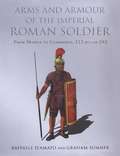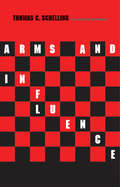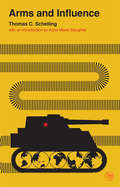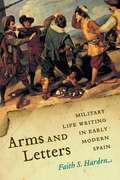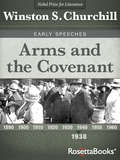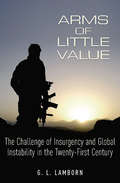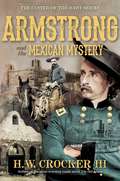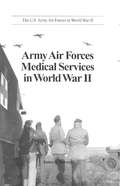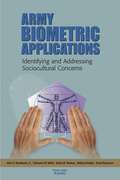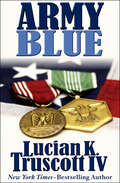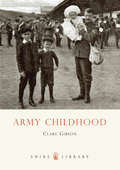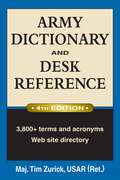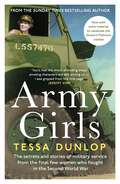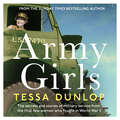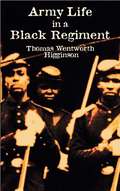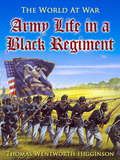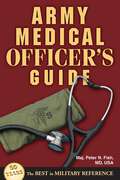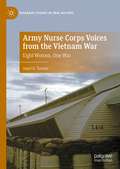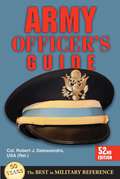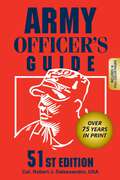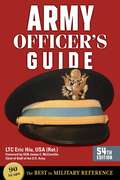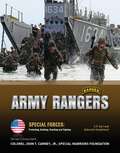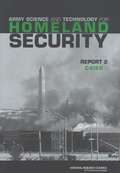- Table View
- List View
Arms and Armour of the Imperial Roman Soldier: From Marius to Commodus, 112 BC–AD 192
by Raffaele D'Amato Graham SumnerA survey of the various forms of armour worn by the Roman soldier from 112 BC to 192 AD, featuring a wealth of illustrations and plates. From the Latin warriors on the Palatine Hill in the age of Romulus, to the last defenders of Constantinople in 1453 AD, the weaponry of the Roman Army was constantly evolving. Through glory and defeat, the Roman warrior adapted to the changing face of warfare. Due to the immense size of the Roman Empire, which reached from the British Isles to the Arabian Gulf, the equipment of the Roman soldier varied greatly from region to region. Through the use of materials such as leather, linen and felt, the army was able to adjust its equipment to these varied climates. Arms and Armour of the Imperial Roman Soldier sheds new light on the many different types of armour used by the Roman soldier, and combines written and artistic sources with the analysis of old and new archaeological finds. With a huge wealth of plates and illustrations, which include ancient paintings, mosaics, sculptures and coin depictions, this book gives the reader an unparalleled visual record of this fascinating period of military history. This book, the first of three volumes, examines the period from Marius to Commodus. Volume II will cover the period from Commodus to Justinian, and Volume III will look at the period from Romulus to Marius. &“An impressive achievement, a testament to an enormous scholarly effort—and it is a significant contribution to the understanding of the Roman army.&” —Bryn Mawr Classical Review &“Without doubt, this is the definitive study of clothing, armour and weaponry worn by Roman soldiers during the golden age of their conquests...D&’Amato has brought together a remarkable collection of archaeological photographs gathered over decades to illustrate every aspect of this military evolution . . . A treasure trove of facts and illustrations that is essential reading for any Roman military enthusiast.&” —Tim Newark, Military Illustrated Magazine
Arms and Influence
by Prof. Thomas C. SchellingThe author concentrates in this book n the way in which military capabilities real or imagined are used, skillfully of clumsily, as bargaining power. He sees the steps taken by the U. S. during the Berlin and Cuban crises as not merely preparations for engagement, but as signals to and enemy, with reports from the adversary's own military intelligence as our most important diplomatic communications.
Arms and Influence (Veritas Paperbacks)
by Thomas C. Schelling&“This is a brilliant and hardheaded book. It will frighten those who prefer not to dwell on the unthinkable and infuriate those who have taken refuge in stereotypes and moral attitudinizing.&”—Gordon A. Craig, New York Times Book Review Originally published more than fifty years ago, this landmark book explores the ways in which military capabilities—real or imagined—are used, skillfully or clumsily, as bargaining power. Anne-Marie Slaughter&’s new introduction to the work shows how Schelling&’s framework—conceived of in a time of superpowers and mutually assured destruction—still applies to our multipolar world, where wars are fought as much online as on the ground.
Arms and Letters: Military Life Writing in Early Modern Spain (Toronto Iberic)
by Faith S. HardenArms and Letters analyses the unprecedented number of autobiographical accounts written by Spanish soldiers during the sixteenth and seventeenth centuries. These first-person retrospective works recount a range of experiences throughout the sprawling domain of the Hispanic monarchy. Reading a selection of autobiographies in contemporary historical context – including the coalescing of the first modern armies, which were partially populated by forced recruits and the urban poor – Faith S. Harden explains how soldiers adapted the concept of honour and contributed to the burgeoning autobiographical form. Harden argues that Spanish military life writing took two broad forms: the first as a petition, wherein the soldier’s service was presented as a debt of honour, and second, as a series of misadventures, staging honour as a spectacle that captivated an audience. Honour was inevitably gendered and performative, and as such, it functioned as one of the overarching metrics of value that early modern men and women applied to themselves and others. In charting how non-elite subjects rendered their lives legitimate through autobiography, Arms and Letters contributes both to a critical genealogy of honour and to the history of life writing.
Arms and the Covenant (Winston S. Churchill Early Speeches)
by Winston S. ChurchillThis inspiring collection of campaign speeches from the British prime minister bring his oratory brilliance and powers of persuasion to life. Legendary politician and military strategist Sir Winston Churchill was a master not only of the battlefield, but of the page and the podium. Over the course of forty books and countless speeches, broadcasts, news items and more, he addressed a country at war and at peace, thrilling with victory but uneasy with its shifting role on the global stage. In 1953, he was awarded the Nobel Prize for Literature for &“his mastery of historical and biographical description as well as for brilliant oratory in defending exalted human values.&” During his lifetime, he enthralled readers and brought crowds roaring to their feet; in the years since his death, his masterful writing has inspired generations of eager history buffs. Well before Britain entered World War II, Winston Churchill warned his government about the growing Nazi threat, even as many European leaders were still urging caution and diplomacy. In this collection of forty-one speeches from 1928 to 1938, the great politician&’s prescience and political skill—vital to Britain&’s role as the first country to stand against Hitler—are clearly on display. This collection, which includes the famous &“Disarmament Fable&” speech, presents a fascinating look at Churchill&’s campaign to mobilize Britian against the rising Nazi threat, and showcases his versatility and genius as one of the best orators of the twentieth century.
Arms of Little Value: The Challenge of Insurgency and Global Instability in the Twenty-First Century
by G. L. LambornIn a dangerous era, a former soldier and CIA officer proposes smarter ways to keep the US safe from the effects of insurgencies around the world. What we&’ve been seeing in Tunisia, Egypt, Libya, Bahrain, Yemen, and elsewhere in recent years is merely the beginning. We are entering an extremely dangerous period in our history. The author, with over a quarter century of intelligence experience, has been a student, an observer—and sometimes a participant—in various insurgencies since his &“initiation&” in Vietnam in 1969. This book offers an understanding of the true nature of insurgency and a glimpse at the reasons why we have not always dealt with it effectively. Drawing from his service in various Third World nations, as well as several successor republics of the former Soviet Union, G.L. Lamborn provides a crucial understanding of what ignites and sustains these movements—and what can prevent them from spreading and spiraling out of control. &“Through case studies and analysis, Lamborn, a former Army and Central Intelligence Agency officer, seeks to explicate the importance of political action to insurgencies and explain how military power is successful only to the extent it delegitimizes an insurgency . . . If readers accept the premise of honest, critical evaluation of military power&’s limits, there is much to be gained from Arms of Little Value.&” —Military Review
Armstrong and the Mexican Mystery (Custer of the West Series #3)
by H. W. Crocker IIIMore fantastical than Harry Turtledove, funnier than Eric Flint, and with definite shades of The Wild, Wild West, the celebrated Custer of the West series—praised by Winston Groom (Forrest Gump), Stephen Coonts (The Flight of the Intruder), and Rob Long (Cheers)—comes to its shocking—and hilarious—climax as George Armstrong Custer, surprise survivor of the Battle of the Little Bighorn, unearths the lost civilization of Atlantis and battles the evil Atlanteans for the fate of the world.NEVER FEAR—ARMSTRONG IS HERE! A mysterious gunman meets Marshal Armstrong in San Francisco with tales of lost gold, unrequited revenge, and an unsolved mystery in Mexico&’s Chihuahuan Desert, inspiring Marshal Armstrong, Ambrose Bierce, and the rest of Armstrong&’s loose band of soldiers of fortune to plunge into an adventure of fierce gunfights, criminal conspiracies, an innovative submarine, and an underground, secret superpower—the remnants of Atlantis—that aims to subvert Western civilization! Can the malevolent, scheming Atlanteans be stopped? That&’s the mission for George Armstrong Custer, traveling incognito as Marshal Armstrong Armstrong, knight-errant. Full of suspense, non-stop action, chivalric romance, and effervescent humor, this is a great place to enter the Custer of the West series! Praise for W.H. Crocker III, and the Custer of the West series: &“The world has a new hero—actually an old hero reimagined—George Armstrong Custer, in this delightfully funny alternative history that&’s better, or at least happier, than the real thing.&” —WINSTON GROOM, best-selling author of Forrest Gump and El Paso &“Droll satire, this is the West as it might have been if the Sioux hadn&’t saved us.&”—STEPHEN COONTS, best-selling author of Flight of the Intruder and The Russia Account &“If Custer died for our sins, Armstrong resurrects him for our delight. Not just the funniest book ever written about an Indian massacre, but laugh out loud funny, period. The best historical comic adventure since George MacDonald Fraser&’s Flashman.&”—PHILLIP JENNINGS, author of Nam-A-Rama and Goodbye Mexico &“A delightful romp that shifts seamlessly between thrilling Western and outlandish farce.&”—GRAYSON QUAY, Modern Age &“The best new novel I&’ve read in years. As rugged as Zane Grey, as funny as P. G. Wodehouse, as smart as Evelyn Waugh, and as sharp as Ambrose Bierce. You don&’t want to miss it.&”—MICHAEL WARREN DAVIS, author of The Reactionary Mind &“Crocker has created a hilarious hero for the ages. Armstrong rides through the Old West setting right the wrongs, and setting wrong the rights, in a very funny cascade of satire, history, and even patriotism.&”—ROB LONG, Emmy- and Golden Globes-nominated screenwriter and co-executive producer of Cheers
Army Air Forces Medical Services In World War II (The U.S. Army Air Forces in World War II #7)
by James S. NaneyThis history summarizes the Army Air Forces (AAF) medical achievements that led to the creation of the Air Force Medical Service in July 1949. When the United States entered World War II, our nation's small aviation force belonged to the U.S. Army and relied on the Army medical system for support. The rapid expansion of the AAF and the medical challenges of improved aircraft performance soon placed great strain on the ground-oriented Army medical system. By the end of the war, the AAF had successfully acquired its own medical system oriented to the special needs of air warfare. This accomplishment reflected the determined leadership of AAF medical leaders and the dedication of thousands of medical practitioners who volunteered for aviation medical responsibilities that were often undefined or unfamiliar to them. In the face of new challenges, many American medics responded with hard work and intelligence that contributed greatly to Allied air superiority.
Army Biometric Applications: Identifying and Addressing Sociocultural Concerns
by Katharine Watkins Webb David Rubenson Elaine M. Newton John D. Woodward Melissa A. BradleyEvery human possesses more than one virtually infallible form of identification. Known as biometrics, examples include fingerprints, iris and retinal scans, hand geometry, and other measures of physical characteristics and personal traits. Advances in computers and related technologies have made this a highly automated process through which recognition occurs almost instantaneously. With concern about its information assurance systems and physical access control increasing, the Army has undertaken an assessment of how it can use biometrics to improve security, efficiency, and convenience. This report examines the sociocultural concerns that arise among soldiers, civilian employees, and the general public when the military mandates widespread use of biometrics. The authors see no significant legal obstacles to Army use of biometrics but recommend that the Army go beyond the provisions of the Privacy Act of 1974 to allay concerns related to this emerging technology. This report should be of interest to those responsible for access control as well as anyone concerned about privacy and technology issues.
Army Blue
by Lucian K. Truscott IVFrom the bestselling author of Dress Gray. &“Part-war story, part-family saga . . . zeroes in on the men of the Blue family, three generations of soldiers&” (The Washington Post). In the eagerly anticipated follow-up to his first novel, Dress Gray, Truscott turns his attention to the Vietnam War and delivers a suspenseful, sprawling court-martial drama set in Saigon in 1969. At twenty-three, platoon leader Lt. Matthew Nelson Blue is the youngest member of an army family; his father is a colonel and his grandfather a profane, cantankerous retired general. Shortly after one of his men is killed by friendly fire while on routine patrol, Blue is arrested and charged with desertion in the face of the enemy. Arriving in Vietnam, his father and grandfather end their long estrangement and join forces to clear the young soldier&’s name. Truscott&’s plot offers less than initially meets the eye; the nature of the conspiracy and cover-up that nearly destroy Blue is fairly easy to predict, as is the disillusionment about Vietnam that eventually befalls his seniors. The author&’s intimate portrayal of the texture of army life gives his narrative a more deeply felt sense of anger and regret than others in its genre, and makes its final revelations more powerful than they might otherwise have been.
Army Childhood
by Clare GibsonAn army childhood is a peripatetic childhood. Taking the Napoleonic Wars as its starting point, Army Childhood sheds light on such crucial aspects of the army-child experience as the places that the children of British Army soldiers have called home, and on how they have been transported, housed, cared for, educated and entertained after the army assumed responsibility for their welfare. This informative and evocatively illustrated book will appeal to those interested in British military history's social side, and to those seeking to understand what life was like for an erstwhile army-child ancestor. It is also essential reading for those who were once themselves 'barrack rats', 'pads' brats', or 'army brats', in whom it is guaranteed to arouse nostalgic memories.
Army Dictionary and Desk Reference
by Tim Zurick USARA top-selling reference now updated and revised to include new and changed terminology of the U.S. Army.
Army Girls: The secrets and stories of military service from the final few women who fought in World War II
by Tessa DunlopArmy Girls is the intimate story of the final few women who served in World War II and are still alive to tell their tale. They were female soldiers in a war Britain wanted to fight without conscripting women. It was a vain hope, by December 1941 for the first time in British history women were called up and a generation of girls came of age in khaki, serving king and country. Barbara trained to drive army-style in giant trucks and Grace swapped her servant's pinafore for battledress and a steel hat, Martha turned down officer status for action on a gun-site and Olivia won the Croix de Guerre in France.Commemorating the 80th anniversary of conscription for women, Army Girls captures remarkable stories from the last surviving veterans who served in Britain's female army and brings to life a pivotal moment in British history. Precious memories and letters are entwined in a rich narrative that travels back in time and sheds new light on being young, female and at war.Uniquely this moving Second World War memoir is embedded in the present day. Written in the midst of a global pandemic, the parallels and paradoxes between two very different national crises are explored in a book that honours the women who fought on in extreme youth and now once more in great old age.
Army Girls: The secrets and stories of military service from the final few women who fought in World War II
by Tessa DunlopArmy Girls is the intimate story of the final few women who served in World War II and are still alive to tell their tale. They were female soldiers in a war Britain wanted to fight without conscripting women. It was a vain hope, by December 1941 for the first time in British history women were called up and a generation of girls came of age in khaki, serving king and country. Barbara trained to drive army-style in giant trucks and Grace swapped her servant's pinafore for battledress and a steel hat, Martha turned down officer status for action on a gun-site and Olivia won the Croix de Guerre in France.Commemorating the 80th anniversary of conscription for women, Army Girls captures remarkable stories from the last surviving veterans who served in Britain's female army and brings to life a pivotal moment in British history. Precious memories and letters are entwined in a rich narrative that travels back in time and sheds new light on being young, female and at war.Uniquely this moving Second World War memoir is embedded in the present day. Written in the midst of a global pandemic, the parallels and paradoxes between two very different national crises are explored in a book that honours the women who fought on in extreme youth and now once more in great old age.(P) 2021 Headline Publishing Group Ltd
Army JROTC Leadership Education and Training (LET #3)
by Pearson Custom PublishingArmy JROTC Leadership Education and Training (LET 3) Third Year of A Character and Leadership Development Program
Army JROTC Leadership Education and Training, First Year
by Pearson Custom PublishingThis book introduces you to the U.S. Army Junior Reserve Officers' Training Corps (JROTC) Program, its mission, and the Leadership Education and Training (LET) curriculum for this first level of your instruction. Completing the material in this course requires discipline and hard work, but the reward is well worth your effort. Through Army JROTC, you are building a foundation that will last a lifetime.
Army Life in a Black Regiment (Civil War)
by Thomas Wentworth Higginson"Army Life in a Black Regiment has some claim to be the best written narrative to come from the Union [side] during the Civil War. Higginson's picture of the battle which was the origin of "praise the Lord and pass the ammunition" and his reading of the Emancipation Proclamation to the black regiment are unsurpassed for eloquence." — historian Henry Steele CommagerOriginally a series of essays, this important volume was written by a Union colonel from New England, in charge of African-American troops training on the Sea Islands off the coast of the Carolinas. A lively and detailed wartime diary, the book offers a refreshing portrait of life in the Union Army from an officer's point of view, recording opinions of other commanders and capturing the raw humor that develops among the men in combat. Higginson's descriptions of the soldiers, routines of camp life, and southern landscapes are unforgettable, as is the account of his near escape from a cannon ball. An unusual historical document intended to introduce new generations of readers to an American past that should not be forgotten, Army Life in a Black Regiment will be invaluable to students of Black History and the American Civil War.
Army Life in a Black Regiment (The World At War)
by Thomas Wentworth HigginsonThomas Wentworth Higginson (December 22, 1823 – May 9, 1911) was an American Unitarian minister, author, abolitionist, and soldier. He was active in the American Abolitionism movement during the 1840s and 1850s, identifying himself with disunion and militant abolitionism. He was a member of the Secret Six who supported John Brown. During the Civil War, he served as colonel of the 1st South Carolina Volunteers, the first federally authorised black regiment, from 1862–1864. Following the war, Higginson devoted much of the rest of his life to fighting for the rights of freed slaves, women and other disfranchised peoples. (Excerpt from Wikipedia)
Army Medical Officer's Guide
by Peter N. FishGuide to the duties, customs, organization, administration, resources, and benefits for medical officers in the U.S. Army.
Army Nurse Corps Voices from the Vietnam War: Eight Women, One War (Palgrave Studies in Oral History)
by Janet D. TannerThis book provides an oral history of women who served in the U.S. Army Nurse Corps during the Vietnam War. It follows the trajectory of eight women’s lives from their decision to become nurses, to surgical and evacuation hospitals in Vietnam, and then home to face the consequences of war on their personal and professional lives. It documents their lived experience in Vietnam and explores the memories and personal stories of nurses who treated injured American soldiers, Vietnamese civilians, and the enemy. Their voices reveal the physical and emotional challenges, trauma, contradictions, and lingering effects of war on their lives. Women in the U.S. Army in Vietnam feared the enemy but also sexual violence and harassment: the experiences this book documents also shed light on the extent of historical sexual abuse in the military.
Army Officer's Guide
by Robert J. Dalessandro David H. Huntoon• Practical advice on Army leadership and command• Fully updated with the latest information for officers of all ranks, branches, and components• Uniforms and insignia, duties and responsibilities, privileges and restrictions, courtesy and customs, posts and organizations, regulations and references• Color images of medals and badges
Army Officer's Guide
by Robert J. DalessandroPractical advice on leadership and officership. Up-to-date information on pay, uniforms, and more.
Army Officer's Guide
by Usa Ltc Eric M. HiuThe Army Officer&’s Guide is the crown jewel of Stackpole&’s military reference line. First published in 1930, this guide has been continuously revised since then and has become the gold-standard reference for the U.S. Army&’s officer corps, especially the new second lieutenants commissioned into the army out of West Point and ROTC programs.This edition has been thoroughly revised and updated with the latest information on leadership, training, military justice, promotions, benefits, counseling soldiers, physical fitness, regulations, and much more—everything the officer needs to know in order to do his job well, to advance his career, to navigate the military, and to guide his soldiers on and off the battlefield.Topics includeHow to train, lead, and counsel troops effectivelyTips on how to move along your career as an NCO by continuing education, training, and professional developmentInformation about all the regulations NCOs need to be aware of in carrying out their jobsAnd much, much more . . .Stackpole has been guiding military officers and soldiers for more than 80 years. Our guides still offer the best advice in the business—better than any other book, better than the internet.
Army Rangers (Special Forces: Protecting, Building, Te)
by C. F. EarlThe Rangers are some of the best-trained and most skilled soldiers in the Army. Their motto--Rangers lead the way!--is not just a slogan; in many of the modern conflicts in which the U.S. military has been involved, the Rangers have been among the first soldiers on the ground. In both Iraq and Afghanistan, Rangers carry out raid, ambush, and rescue missions, as well as many other kinds of operations. Army Rangers gives readers a view into the world of the highly skilled Seventy-Fifth Ranger Regiment, today's Rangers, as well as a look at the history of the unit. Since the Revolutionary War, Ranger tactics and standards have been some of the most effective in the entire military. The book also includes information about: * The tough training courses that all Rangers must endure. * What kinds of weapons the Rangers use today and throughout history. * How the modern Rangers were organized and put into action around the world.
Army Science And Technology For Homeland Security: Report 2
by Committee on Army Science Technology for Homeland Defense--C4ISRShortly after the events of September 11, 2001, the U.S. Army asked the National Research Council (NRC) for a series of reports on how science and technology could assist the Army meet its Homeland defense obligations. The first report, Science and Technology for Army Homeland Security—Report 1, presented a survey of a road range of technologies and recommended applying Future Force technologies to homeland security wherever possible. In particular, the report noted that the Army should play a major role in providing emergency command, control, communications, computers, intelligence, surveillance, and reconnaissance (C4ISR) capabilities and that the technology and architecture needed for homeland security C4ISR was compatible with that of the Army’s Future Force. This second report focuses on C4ISR and how it can facilitate the Army’s efforts to assist the Department of Homeland Security (DHS) and emergency responders meet a catastrophic event.
